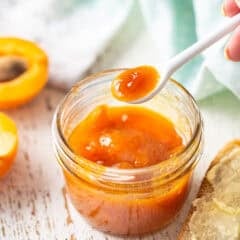Coconut Shrimp
As an amazon associate I earn from qualifying purchases.
You won’t want to stop eating these coconut shrimp! So light & crisp, with the perfect balance of sweet & savory. Great app or main course!
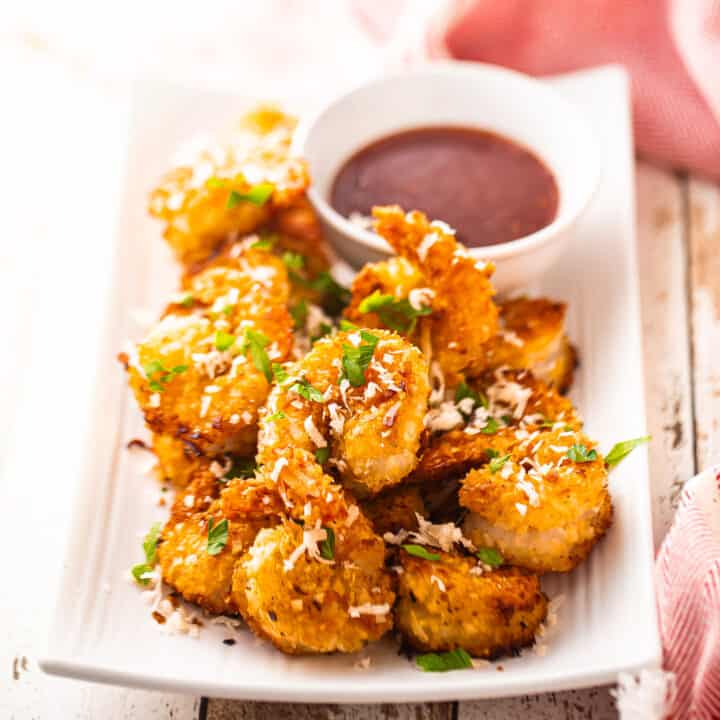
Hey there! Today I’m so excited to be bringing you one of the most fun and delicious recipes ever: coconut shrimp!
These can be served as an appetizer OR a main course, and they are so light and crisp and wonderfully addictive!
When I made them, we enjoyed them as our dinner, paired with fluffy cooked rice with a little lime zest and sliced scallion folded in, and a side of steamed green beans.
Perfectly delish!
But I think they work really well as hors d’oeuvres too!
Similar to my favorite garlic knots recipe, or my homemade soft pretzels or pigs in a blanket, you could pile this coconut shrimp recipe on a big platter, add a little bowl of dipping sauce, and let your guests go to town!
It’s great game-day grub!
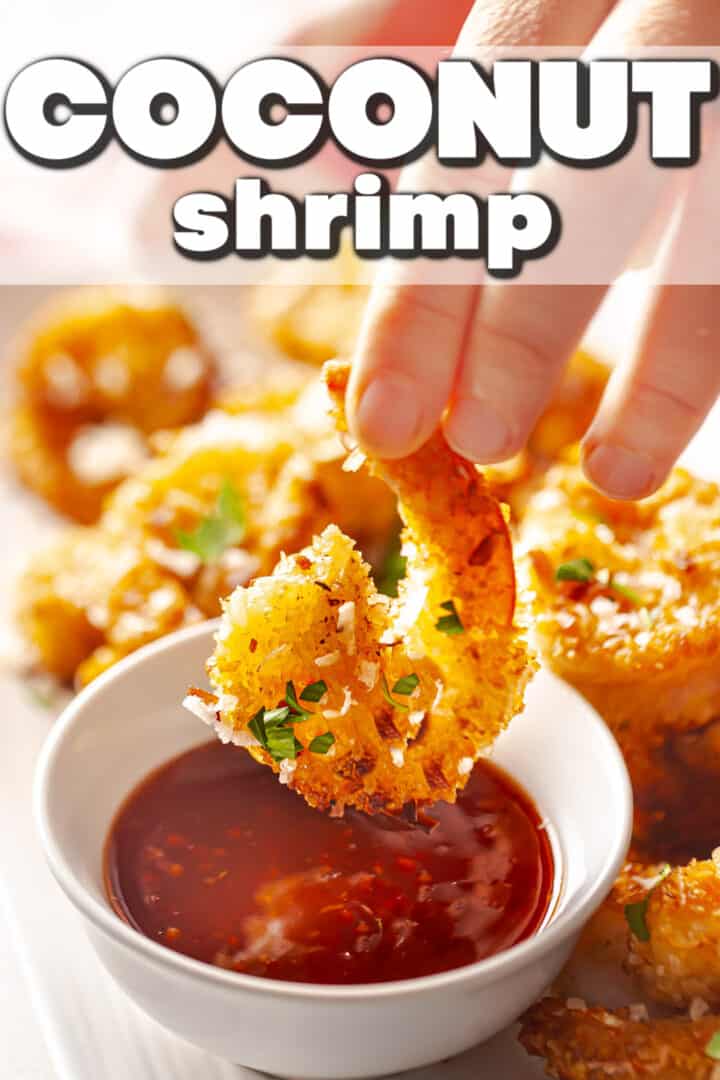
Table of Contents
- What are coconut shrimp?
- What’s great about this coconut shrimp recipe
- What do coconut shrimp taste like?
- Ingredients
- Special equipment
- How to make coconut shrimp
- How to serve coconut shrimp
- Expert tips
- Frequently asked questions
- How to store
- A few more of my favorite savory recipes
What are coconut shrimp?
Coconut shrimp are basically just shrimp that have been coated in a breadcrumb mixture that’s made with shredded coconut.
They’re usually then fried, although they can also be baked for a healthier option.
They cook up crispy, crunchy, and light, and they’re usually served with some type of dipping sauce or drizzle.
What’s great about this coconut shrimp recipe
- Tastes amazing: The balance of sweet and savory is perfectly harmonious.
- Few ingredients: You’ll only need a handful of basic ingredients to make this.
- Easy to make: The whole batch is done in about a half hour.
- Addictively crispy: Crisp, light, and meaty. A winning combination every time!
What do coconut shrimp taste like?
When you take a bite of a coconut shrimp, the first thing that will strike you is the taste of the breading.
It’s shatteringly crisp and has a hint of tropical coconut flavor. It’s also slightly sweet.
This sweetness pairs perfectly with shrimp.
The shrimp are meaty, with that unmistakable taste of the sea.
Together, these two elements combine for a real taste sensation!
Combine that with a sweet, slightly spicy dipping sauce, and you have a truly stellar dish on your hands!
Ingredients
You’ll just need a handful of ingredients to make this recipe.

Shrimp
You’ll want to purchase raw shrimp for this recipe.
I like to buy the frozen, deveined shrimp with shells on. They come in a big, 2-pound bag. I then thaw them out and remove the shells, leaving the tail intact so it can act like a little handle.
The bigger the better! Jumbo shrimp have such incredible meaty flavor. Look for the U rating: the smaller the number the larger the shrimp. I look for around U/12 if I can get it!
Seasonings
Just a little salt & pepper to enhance the savory flavors.
I like kosher salt best because it doesn’t have any additives (table salt usually contains iodine, which can leave a bitter taste), so the flavor is pure. It’s also inexpensive and easy to find in a regular grocery store.
Use black pepper if you like, or cayenne if you want your shrimp a little spicier.
Flour
All-purpose flour is my go-to, but you can swap it out for any kind of whole-grain option if you like.
A gluten-free flour blend that can sub 1:1 for regular flour should also work just fine, if you’d like to make gluten-free coconut shrimp.
Eggs
Eggs provide the “glue” that allows the coconut breading to stick to the shrimp.
For an egg-free option, swap in your favorite plant-based egg substitute.
Water
Beat a little water into the eggs, just to thin them out enough to coat the shrimp evenly.
Coconut
I like to use sweetened, shredded coconut. But you could use the unsweetened kind too if you prefer!
Breadcrumbs
Panko breadcrumbs provide the lightest, crispest texture! They are a Japanese invention and they’re prepared in a very special way to make them super crispy.
Regular breadcrumbs will work too, in a pinch.
Either way, make sure they’re unseasoned.
Oil
If you decide to make your coconut shrimp in the oven (instructions below), you won’t need this ingredient.
But I do prefer my coconut shrimp lightly fried. They come out so light and crisp!
Use any kind of neutral-tasting oil that has a high smoke point. Some good options would be vegetable oil, canola oil, sunflower oil, or peanut oil.
Special equipment
Here are the tools you’ll need to make this coconut shrimp recipe.
- Paper towels: For blotting the shrimp dry, as well as for draining off excess oil after frying.
- Shallow bowls: To hold the flour, eggs, and breading mixture.
- Whisk or fork: For beating the eggs and water together.
- Large skillet: The bigger the pan, the more shrimp you can cook at once.
How to make coconut shrimp
This recipe comes together in 5 simple steps.
Step 1: Season the shrimp
If they haven’t already come that way, remove the shells from the shrimp and devein them.
Then, pat them dry and sprinkle them with salt and pepper on each side.
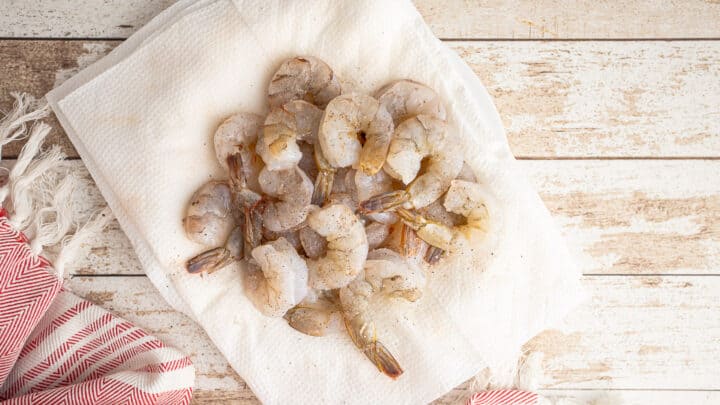
Step 2: Dredge in flour
Next, give them a light dusting of flour.

Shake them off to release any excess. You just want the barest whisper of flour here.
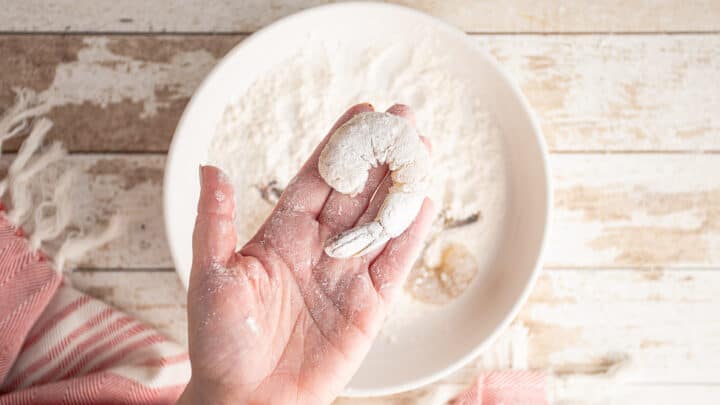
Step 3: Coat in egg
Thin the eggs out slightly by beating them together with a little bit of water.
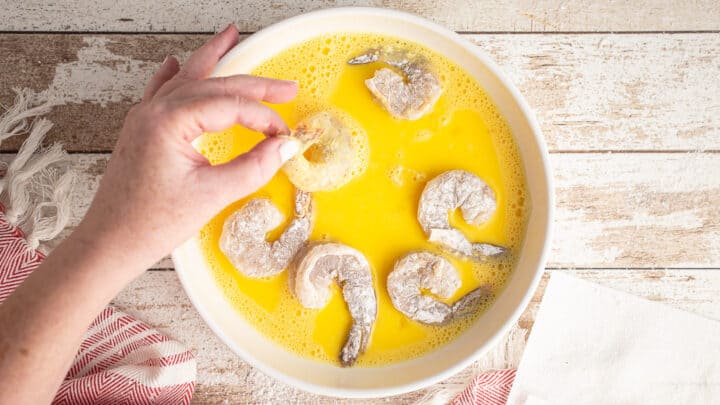
Then give the shrimp a quick dip in this egg wash.
Step 4: Bread the shrimp
Place the breadcrumbs and shredded coconut in a large, shallow bowl.
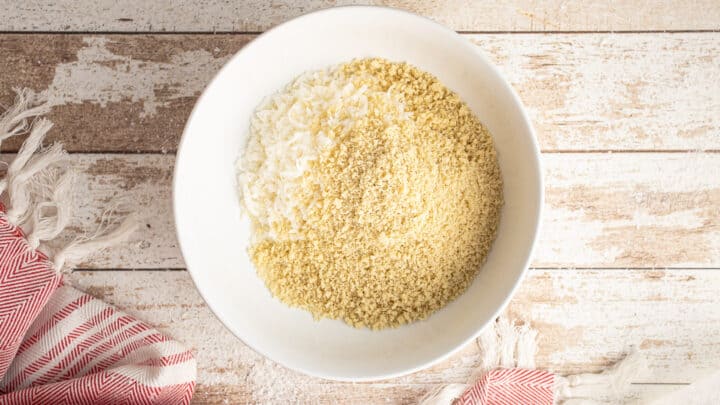
Give them a quick stir to get them combined.
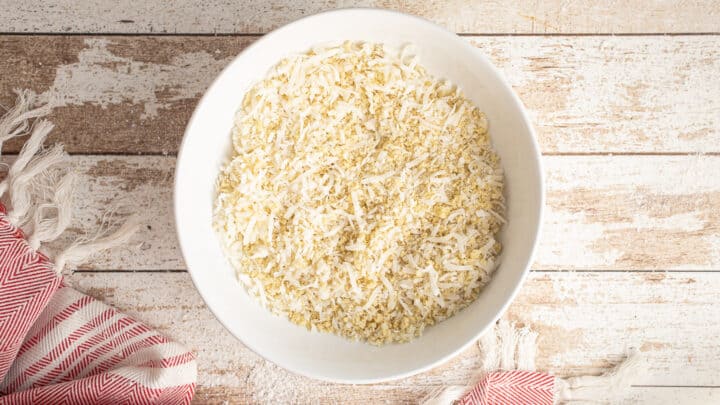
And coat the egg-dipped shrimp in this mixture.

It’s not a bad idea to lightly press the breading into the egg, to get it to really adhere.
Step 5: Cook
Place a large skillet over medium heat and add in your oil.
When the oil hits around 325 to 375 degrees F, you can start frying the shrimp, in batches.
Be careful not to put too many shrimp in at once, or they’ll steam and the breading will go gummy, rather than frying up nice and crisp.
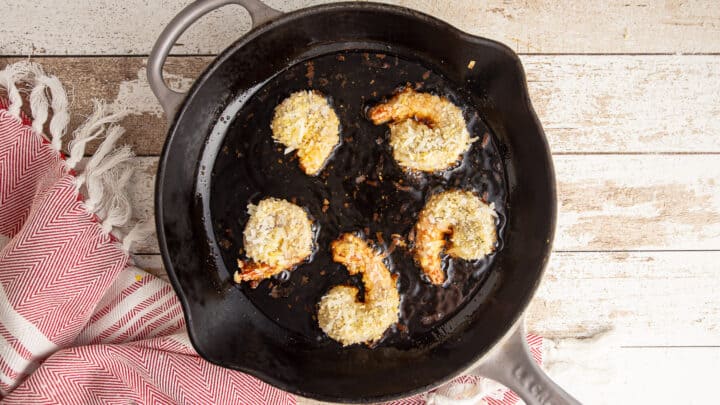
You’ll know your coconut shrimp are done cooking when they look golden browned on both sides. They should curl up slightly, forming a “C” shape.
How to serve coconut shrimp
When the shrimp are done cooking, remove them from the pan and place them on paper towels so the excess oil can drain off.
Then just tumble them onto a platter, fill a small bowl with dipping sauce, and let everyone have at it!
Or, plate them with some cooked rice and veggies, and drizzle the sauce on top, to make a healthy and satisfying supper.
If you want to make them extra pretty, shower them with a little chopped flat-leaf parsley and some additional shredded coconut, like I did here.
Expert tips
Prep ahead: If you have the time, it’s a good idea to prep these shrimp ahead of time, and let them chill for a little while in their little breading sweaters. This helps the breading to adhere really well, and not fall off during the cooking process.
Use a thermometer: An instant-read digital thermometer is a great kitchen tool and it doesn’t cost much. You can use this not only for frying, but for checking the doneness of meats, breads, and candy. If you don’t know what the temperature of your oil is, it can lead to a lot of issues (more on that below).
Make them ahead: If you’re planning a party or holiday get-together, it’s nice to get the heavy-duty cooking out of the way before your guests arrive. So try cooking these an hour or so before you plan to serve them. They can be arranged in a single layer on a wire rack set over a baking sheet, and kept warm in the oven at 170 degrees F. This will keep them nice and crisp.
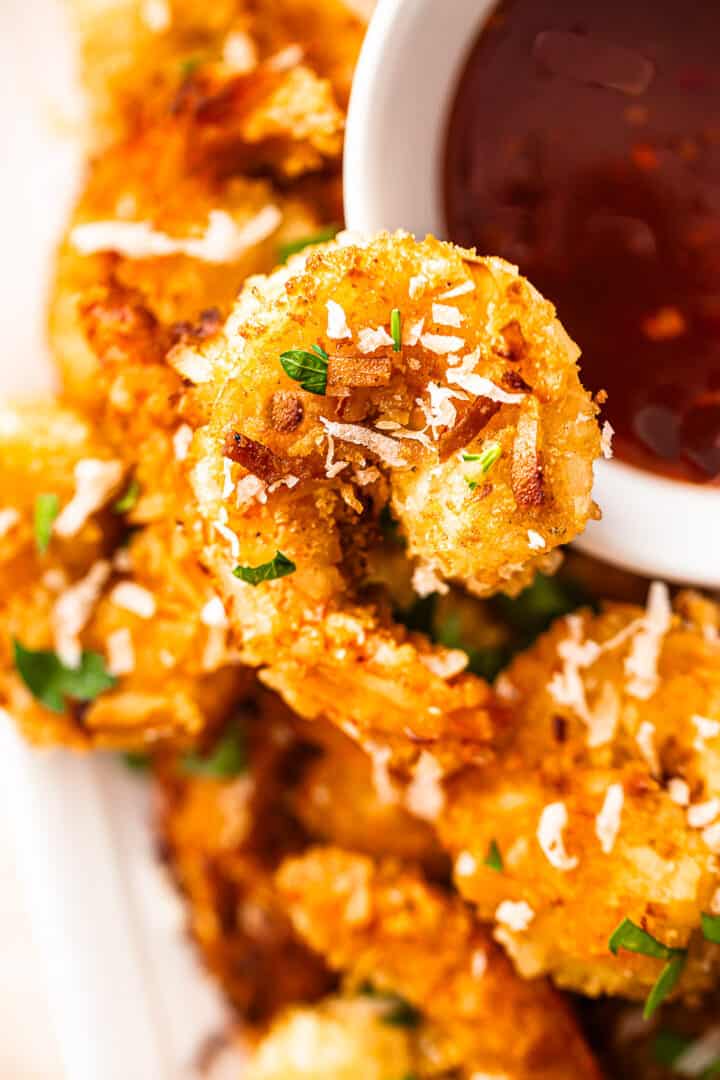
Frequently asked questions
Can these be baked instead of fried?
Yes! They won’t come out quite as golden and crisp but they will be healthier! And they’ll taste great.
Bake them at 400 degrees F on a wire rack set over a baking sheet.
You’ll know they’re done when they feel firm (not squishy) and they have that unmistakable “C” shape.
Can I use unsweetened coconut?
You definitely can if that’s what you prefer. They will be less sweet (obvs) and they may take a little longer to turn golden brown.
Can I make this coconut shrimp recipe in the air fryer?
Yes! Set the temperature of your air fryer or convection oven to 375 degrees F and follow the doneness cues noted above.
Why did my coconut shrimp come out too dark on the outside and underdone in the middle?
This can happen if your frying oil is too hot. I highly recommend checking it with a thermometer, several times throughout the cooking process.
You’ll see the temperature fluctuate, and you can make those necessary adjustments to keep things between 325 and 375 degrees F.
Why did my coconut shrimp come out gummy and/or greasy?
This question has a similar answer to the one before it: it’s all about the oil temperature. In this case, the oil temp is probably too low.
Or, it could be a result of overcrowding the pan with too many shrimp at once. Make sure they have some room to breathe!
How do I know when my shrimp are properly cooked?
The recommended internal cooking temperature for shrimp is 145 degrees F, so you can use that same thermometer for this purpose as well.
Or just look for those visual cues: the breading should look golden, the tails should look bright, coral-y pink, and the shrimp should form a tight “C” shape.
If it makes a complete circle it’s probably overcooked and could be rubbery.
If it’s elongated and not quite curled enough it will have a really unpleasant slippery, squishy texture.
What kind of dipping sauce is best for coconut shrimp?
I would have loved to have given you some groundbreaking new coconut shrimp sauce recipe, but I tried a few different things and nothing quite measured up to good ol’ sweet chili sauce!
The sweetness compliments the shrimp in the most delicious way, and that little whisper of heat provides the most delicious balance!
How to store
These can be left out at room temperature for a couple of hours, but if you have any leftovers they should be placed in an airtight container and refrigerated or frozen.
They should keep in the fridge for 3 to 4 days, or in the freezer for a few months. They can be thawed in the fridge and warmed in a 170 degree F oven until heated through.
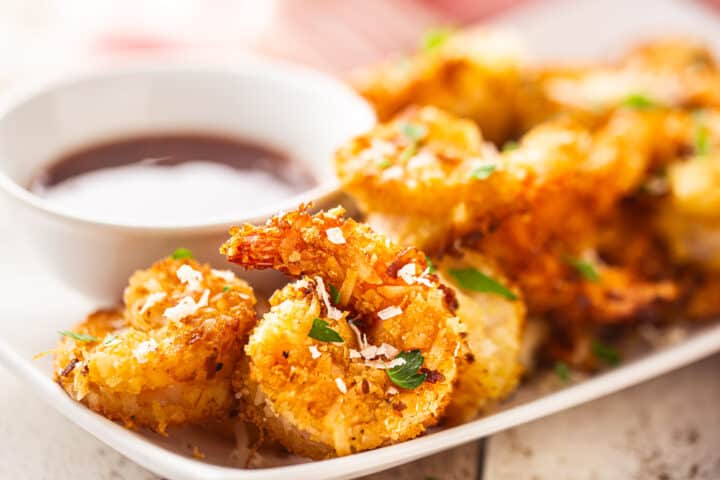
A few more of my favorite savory recipes
As an amazon associate I earn from qualifying purchases.
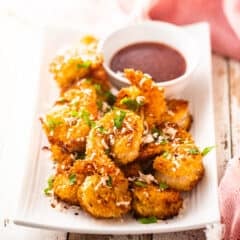
Coconut Shrimp
Ingredients
- 1 pound (453.59 g) shrimp, raw (peeled and deveined)
- 3/4 teaspoon (4.5 g) kosher salt
- 1/4 teaspoon (0.5 g) black pepper
- 1/2 cup (62.5 g) all-purpose flour
- 2 (88 g) eggs, large
- 2 teaspoons (10 g) water
- 1 cup (80 g) shredded coconut
- 1/2 cup (30 g) panko breadcrumbs
- 1/2 cup (112 g) oil, for frying
- sweet chili sauce, for dipping
Instructions
- Blot the shrimp dry and season on both sides with salt and pepper.
- Lightly dust the shrimp in flour, knocking off any excess.
- Beat the eggs and water together until combined, then dip in each shrimp to coat.
- Combine the coconut and breadcrumbs in a large, shallow bowl.
- Coat the egg-dipped shrimp in the coconut mixture, pressing lightly to adhere.
- Heat the oil in a large skillet until it reaches 325 to 375 degrees F.
- Working in small batches so as not to crowd the pan, lightly fry the shrimp (turning) until golden and crisp on both sides (approx. 3 to 5 minutes on each side).*
- Drain, and serve with sweet chili sauce for dipping.









